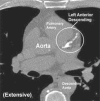Expert review on coronary calcium
- PMID: 18561507
- PMCID: PMC2496978
- DOI: 10.2147/vhrm.s1160
Expert review on coronary calcium
Abstract
While there is no doubt that high risk patients (those with >20% ten year risk of future cardiovascular event) need more aggressive preventive therapy, a majority of cardiovascular events occur in individuals at intermediate risk (10%-20% ten year risk). Accurate risk assessment may be helpful in decreasing cardiovascular events through more appropriate targeting of preventive measures. It has been suggested that traditional risk assessment may be refined with the selective use of coronary artery calcium (CAC) or other methods of subclinical atherosclerosis measurement. Coronary calcification is a marker of atherosclerosis that can be quantified with the use of cardiac CT and it is proportional to the extent and severity of atherosclerotic disease. The published studies demonstrate a high sensitivity of CAC for the presence of coronary artery disease but a lower specificity for obstructive CAD depending on the magnitude of the CAC. Several large clinical trials found clear, incremental predictive value of CAC over the Framingham risk score when used in asymptomatic patients. Based on multiple observational studies, patients with increased plaque burdens (increased CAC) are approximately ten times more likely to suffer a cardiac event over the next 3-5 years. Coronary calcium scores have outperformed conventional risk factors, highly sensitive C-reactive protein (CRP) and carotid intima media thickness (IMT) as a predictor of cardiovascular events. The relevant prognostic information obtained may be useful to initiate or intensify appropriate treatment strategies to slow the progression of atherosclerotic vascular disease. Current data suggests intermediate risk patients may benefit most from further risk stratification with cardiac CT, as CAC testing is effective at identifying increased risk and in motivating effective behavioral changes. This article reviews information pertaining to the clinical use of CAC for assessing coronary atherosclerosis as a useful predictor of coronary artery disease (CAD) in certain population of patients.
Figures





References
-
- Akosah KO, Shaper A, Cogbill C, et al. Preventing myocardial infarction in the young adult in the first place: how do the National Cholesterol Education Panel III guidelines perform? J Am Coll Cardiol. 2003;41:1475–9. - PubMed
-
- Anand DV, Lim E, Hopkins D, et al. Risk stratification in uncomplicated type 2 diabetes: prospective evaluation of the combined use of coronary artery calcium imaging and selective myocardial perfusion scintigraphy. Eur Heart J. 2006;27:713–21. - PubMed
-
- Arad Y, Goodman KJ, Roth M, et al. Coronary calcification, coronary disease risk factors, C-reactive protein, and atherosclerotic cardiovascular disease events: the St. Francis Heart Study. J Am Coll Cardiol. 2005;46:158–65. - PubMed
-
- Arad Y, Spadaro LA, Roth M, et al. Treatment of asymptomatic adults with elevated coronary calcium scores with atorvastatin, vitamin C, and vitamin E: The St. Francis Heart Study Randomized Clinical Trial. J Am Coll Cardiol. 2005;46:166–72. - PubMed
-
- Arad Y, Sparado LA, Goodman K, et al. Prediction of coronary events with electron beam computed tomography. J Am Coll Cardiol. 2000;36:1253–60. - PubMed
Publication types
MeSH terms
Substances
LinkOut - more resources
Full Text Sources
Medical
Research Materials
Miscellaneous

